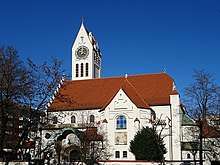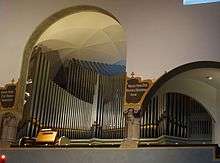Erlöserkirche, Munich
The Erlöserkirche (Church of the Redeemer) is the oldest Lutheran church in Schwabing, part of Munich, Bavaria, Germany.[1] The full name is Evangelisch-Lutherische Erlöserkirche. It was built from 1899 to 1901 on a design by Theodor Fischer, in a style combining historicism and Jugendstil.

%2C_001.jpg)

History
The Lutheran congregation in predominantly Catholic Schwabing had only a small Bethaus (prayer house). A church was planned to accommodate a growing population in the still rural suburb,[2] where Wassily Kandinsky, Paul Klee and Thomas Mann lived. It was designed by Theodor Fischer who followed the model of a classical basilica such as St. Anna im Lehel.[3] The style recalls historicism, but includes Jugendstil decoration and shows a tendency to clearer modern structure.[4] The architect, who designed the first church in his career, planned "eine echt protestantische Kirche, [...] in erster Linie ein[en] Predigtsaal, in dem das Wort lebendig werde" ("a true Protestant church, first of all a hall for the sermon, to make the word come alive").[5][6]
The pulpit is a central element of the interior. The altar is in focus in a richly decorated apse.[5] The church was consecrated on 6 October 1901.[7] In 1976, the altar was moved forward, closer to the congregation.[5] Today the church is located at the Münchner Freiheit, a prominent location in the cityscape.[3][5]
Features
The church has an exterior relief by Hermann Lang, showing Thomas and Jesus, with Thomas acknowledging Jesus as the redeemer,[8] and two reliefs by Ernst Neumeister after Fischer's designs. The altar and the pulpit are made from yellowish marble from Verona. The large painting in the apsis was created by Linda Kögel. Jesus on a throne, surrounded by angels, sits above scenes from parish life such as baptism, wedding and funeral, with portraits of parish members at the time.[5]
When the church was built, an organ was built on the southern gallery by G. F. Steinmeyer & Co. (Oettingen), with two manuals and 21 stops. It was expanded in 1938 by Albert Moser to 49 stops and electric traction, and an overhaul followed in 1962 by the Kaufbeuren company Orgelbau Schmid.[9] A second organ was built by Rieger Orgelbau on the west gallery in 1990. It has three manuals and pedals with 43 stops.[10]
References
- Rogasch, Wilfried (5 May 2015). "Eine Predigtkirche in Schwabing". Oberbayerisches Volksblatt (in German). Retrieved 21 June 2018.
- Stock, W.J.; Gerhards, A.; Schwebel, H.; Kinold, K. (2006). Europäischer Kirchenbau: 1900–1950 : Aufbruch zur Moderne (in German). Prestel. p. 28. Retrieved 20 June 2018.
1901 Erlöserkirche München, Deutschland Church of the Redeemer Munich, Germany ln den Jahren um 1900 bezog sich ... lm Stadtteil Schwabing gelegen, erhob sich die Erlöserkirche ursprünglich inmitten einer noch dörflichen Umgebung.
- "München/Schwabing: Erlöserkirche / Ein Stück Münchner Freiheit" (in German). Munich. Archived from the original on 17 June 2018. Retrieved 17 June 2018.
- Ottomeyer, H.; Brandlhuber, M. (1997). Wege in die Moderne: Jugendstil in München, 1896 bis 1914 (in German). Klinkhardt + Biermann. p. 18. ISBN 978-3-7814-0406-9. Archived from the original on 21 June 2018. Retrieved 21 June 2018.
... Im katholischen Kirchenbau finden wir den Historismus, den Stil nach Wahl, in seiner vollen Blüte: St. Ursula, als Kopie einer ... Und Theodor Fischer versuchte, mit der protestantischen Erlöserkirche einen neuen evangelischen Kirchentyp ...
- Stoltz, Philipp. "Erlöserkirche". Straße der Moderne (in German). Archived from the original on 21 June 2018. Retrieved 17 June 2018.
- Dienes, G.M.; Flitsch, J.; Stadtmuseum Graz; Leitgeb, F. (1996). "transLOKAL": 9 Städte im Netz (1848–1918) : Bratislava/Preßburg, Brno/Brünn, Graz, Kraków/Krakau, Ljubljana/Laibach, München, Pécs/Fünfkirchen, Trieste/Triest, Zagreb/Agram : [Ausstellungskatalog des Grazer Stadtmuseums]. Ausstellungskatalog des Grazer Stadtmuseums (in German). Leykam. p. 566. ISBN 978-3-7011-7335-8. Retrieved 21 June 2018.
... Nach eigener Aussage wollte er "einen echt protestantischen Predigtsaal, in dem das Wort lebendig werde"
- Bauer, R.; Weidlich, K. (1993). Schwabing: das Stadtteilbuch (in German). HPV/Historika Photoverlag. p. 50. Archived from the original on 21 June 2018. Retrieved 21 June 2018.
Erlöserkirche Protestantische Gottesdienste wurden in Schwabing erst im alten Schulhaus in der Haimhauser Straße abgehalten. Gerade ... April 1900 gelegt und bereits am 6. Oktober 1901 konnte das Gebäude eingeweiht werden. Es bietet ...
- Süddeutsche Bauzeitung (in German). 1914. p. 175. Archived from the original on 21 June 2018. Retrieved 21 June 2018.
Eine besonders liebevolle Durchbildung in vorerwähnten Sinne erfuhr die Erlöserkirche in Schwabing (1899–1901) mit einem tiefempfundenen Christusrelief von Bildhauer Hermann Lang, München, an der Aussenseite der Kirche, von der nur ...
- "Benefizkonzert Frühjahr 2014 – "Moser-Orgel"". Abaco Orchester (in German). Archived from the original on 21 June 2018. Retrieved 21 June 2018.
- Doering, Martin. "Disposition der Orgel in / Specification of the Organ at München (Schwabing), Erlöserkirche (Westemporenorgel)". Die Orgelseite (in German). Archived from the original on 1 April 2016. Retrieved 21 June 2018.
Literature
- Gallas, Klaus (1979). München : von der welfischen Gründung Heinrichs des Löwen bis zur Gegenwart ; Kunst, Kultur, Geschichte (in German). Köln: DuMont. ISBN 3-7701-1094-3. OCLC 263645671.
- Kitzmann, Armin (1990). Das offene Tor : aus der Geschichte der Protestanten in München (in German). München: Claudius Verlag. ISBN 3-532-62094-4. OCLC 22474958.
- Koch, Klaus (1976). Erlöserkirche München-Schwabing 1901–1976. Ein Stück Münchener Freiheit. Eine Dokumentation (in German). München: Selbstverlag der Evang.-Luth. Kirchengemeinde Erlöserkirche.
- Langenberger, S. (1907). "Die Erlöserkirche in München". Süddeutsche Bauhütte: Illustr. Zeitschrift für Hoch- u. Tiefbau u. das gesamte Baugewerbe. Bayerisches Submissionsblatt. 18. Carl Haushalter. (später): Georg D.W. Callwey.
External links
| Wikimedia Commons has media related to Erlöserkirche (Munich). |
- Literature by and about Erlöserkirche, Munich in the German National Library catalogue
- Official website
- Blatt 98, design by Fischer, in the Architekturmuseum der Technischen Universität Berlin
- Blatt 99, design by Fischer, in the Architekturmuseum der Technischen Universität Berlin